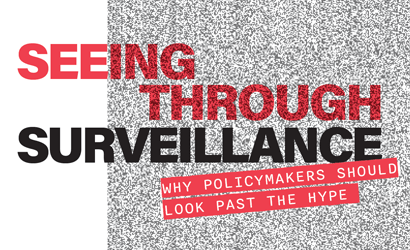Trump is Coming, This Time with Artificial Intelligence. Our New Report Will Help Us Meet the Moment
Page Media

With President-elect Trump about to assume office, we know what’s coming. We know he intends to employ the full might of the government’s surveillance capacities to deport, harass, arrest, and terrorize the most vulnerable people in our country. But this time around, Trump could be further aided by new artificial intelligence-powered surveillance systems that extend his reach into our neighborhoods, families, and personal lives – systems that can automate mass surveillance, increase high-tech profiling, and supercharge biased policing.
At the ACLU of Northern California, we’ve been preparing. We know that our lawmakers and communities need resources to understand where and how they can defend against dangerous surveillance and make smart decisions about public safety.
Our new report, Seeing Through Surveillance: Why Policymakers Should Look Past the Hype, was designed to meet this moment.
With dozens of case studies, key questions to ask and answer, and examples of effective alternatives to surveillance, Seeing Through Surveillance and its accompanying materials provide lawmakers and community members with the knowledge and tools they need to build a firewall that helps keep people safe.
As it stands, California’s information collection and sharing practices can be downright dangerous. For example, the state’s six fusion centers harvest people’s location, identity, biometrics, and social media activity – and often make this information available to the very agencies that President-elect Trump wants to weaponize. These domestic spy centers have little to no recorded public safety benefit, but they have been used to improperly surveil immigrants, Arab Americans, and environmental justice, reproductive justice, racial justice activists, and other peaceful advocates.
This problem is made worse by surveillance companies that take the public for a ride, selling communities on invasive and ineffective systems as a snake oil fix to longstanding policy challenges. What profit-seeking vendors tout as a magic fix to our public safety challenges may be ineffective and end up further harming the people most at risk of government abuse.
While Trump is currently the most visible threat, the problem extends beyond him. When our cities and state track who we are, where we go, what we do, and who we know, they are putting a target on their own constituents’ backs. The surveillance networks, databases, and dossiers built locally can easily be coopted by federal and out-of-state agencies to tear apart immigrant communities, retaliate against activists, and hunt those who travel for abortion or gender affirming care.
Sometimes the danger isn’t even from the government. The news is filled with examples of hackers who find easy ways to exploit surveillance networks or break into government-held databases to steal people’s information and distribute it across the web.
However, these invasive and dangerous surveillance systems can be effectively challenged on the state and local level. With lessons learned from over two decades of groundbreaking work by the ACLU NorCal Technology and Civil Liberties Program, our new report provides tools to critically analyze and challenge surveillance. It also provides examples of effective and creative non-surveillance solutions that have been used to address pressing public safety needs.
The report includes a host of examples of communities that increased public safety by opting for alternative solutions, such as speedbumps instead of speed cameras, trees instead of tracking devices, and city beautification over biometric spying.
Taken together, these case studies show how surveillance is not inevitable, or even necessary, if we listen to what communities want and roll out evidence-backed solutions rather than default to intrusive technologies that cause more problems than they solve.
And while the danger of AI-powered surveillance is growing, fortunately so too is the grassroots movement fighting back. Dozens of communities in California and across the country have to enact important laws that limit information collection and sharing, bring independent oversight, and prohibit systems such as face surveillance.
The full report, and supplemental resources including a Seeing Through Surveillance One Pager, Surveillance Technology Impact Worksheet, and Policymaker Brief are all available at https://www.aclunc.org/SeeThroughTheHype.
